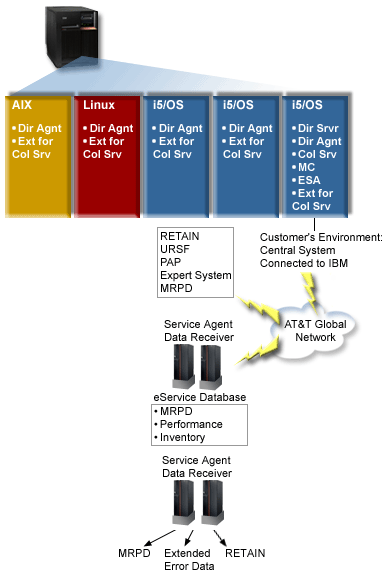IBM® Performance
Management for  iSeries™ (PM eServer™ iSeries) automatically triggers Collection
Services to gather nonproprietary performance and capacity data from your
server and then sends the data to IBM for analysis.
iSeries™ (PM eServer™ iSeries) automatically triggers Collection
Services to gather nonproprietary performance and capacity data from your
server and then sends the data to IBM for analysis.
One of the analyses PM iSeries provides is to plot the growth of the system to determine when an upgrade may be necessary. For a system that is not partitioned, this is a straightforward process. However, if your system has been partitioned into multiple i5/OS™ partitions, the data arrives at IBM from each partition separately, which makes forming a reliable view of the entire system performance more difficult. If the partitions are running AIX® or Linux®, or if any of the i5/OS partitions have PM iSeries turned off, then no data is sent, which makes forming a view of the entire system nearly impossible.
To address these problems, Collection Services, with IBM Director Multiplatform, can now retrieve data about CPU usage and number of processors available from your server partitions regardless of the operating system running on them. PM iSeries summarizes the data before it gets shipped to IBM. Providing a cross-partition view of CPU utilization helps you and IBM do a much better job of managing your system resources. This includes balancing workload across the current set of processors as well as being able to plan for the purchase of more or faster processors when necessary.
How does it work?
The graphic below illustrates how the collection of CPU utilization data across logical partitions works. The "central system" has the IBM Director Server installed on an i5/OS partition that is running Collection Services with the *LPAR category selected. Each of the other partitions must have the IBM Director Agent installed and configured so that IBM Director Server can collect performance data from them. Each partition must also have the Director Multiplatform extension for Collection Services installed. IBM Director Server retrieves the CPU utilization data for each partition, including itself, at regular intervals and stores that data in the Collection Services *MGTCOL object. The data is then processed and written to the QAPMLPAR database file. Finally, PM iSeries collects and aggregates the data and prepares to transmit it to IBM. Although this graphic shows Management Central and IBM Electronic Service Agent™ (ESA) set up to transmit data on the same partition as the IBM Director Server and Collection Services, the transmission mechanism to IBM could actually be running on a completely different system and still be set up to gather the cross-partition data from PM iSeries and send it to IBM, business as usual.

| Key |
|---|
Dir Srvr = IBM Director Server |
Set it up
The following list provides you with an overview of the steps you must complete to collect performance data across logical partitions:
 You can use the following tools to track performance data
across partitions:
You can use the following tools to track performance data
across partitions:- Collection Services
- PM iSeries
- IBM eServer Workload Estimator
